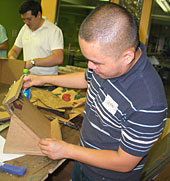Images source: Adaptive Design Association
To be honest, discussions about ethics can be a downer, because you end up talking about what’s wrong and the positive stories set the ethical bar so high to instill a sense of defeat from the start. Here is a post dedicated to the middle ground.
A couple of years ago, I once took a class at the Adaptive Design Association which offers in training in adaptive design and creating custom equipment for children with disabilities. Adaptive design takes existing objects and makes them more accessible or using common and inexpensive materials for custom fabrication. ADA promotes hacks such as making custom furniture out of corrugated cardboard, as well as, basic techniques such as making normal drawers accessible with the simple hack of adding straps to the knobs or handles.
Sometimes ethical design is not just about making life saving products or about arguing that every single thing that is designed needs to be made accessible to everyone. There are times when design can be maximized for the majority of people. I don’t think thriving for ethical design should demand that all drawers have straps for opening instead of knobs. Although the basic design curriculum should include instruction on the consideration that something like drawer handles can be designed to be more easily adapted. The designer’s responsibility is not removed completely from the obligation of university access. They must still consider ensure that her designs are easily adapted for special cases.
Why shouldn’t all design be universally accessible? My main argument is that, often, it is better for able bodied people to use their bodies. Talking the stairs for one or two flights is, in fact, better than than forcing people to take elevators, which usually happens in most tall buildings. The middle ground would be for all design to include the allowance for a certain amount of hackability, to allow for the easy modification for special cases.




